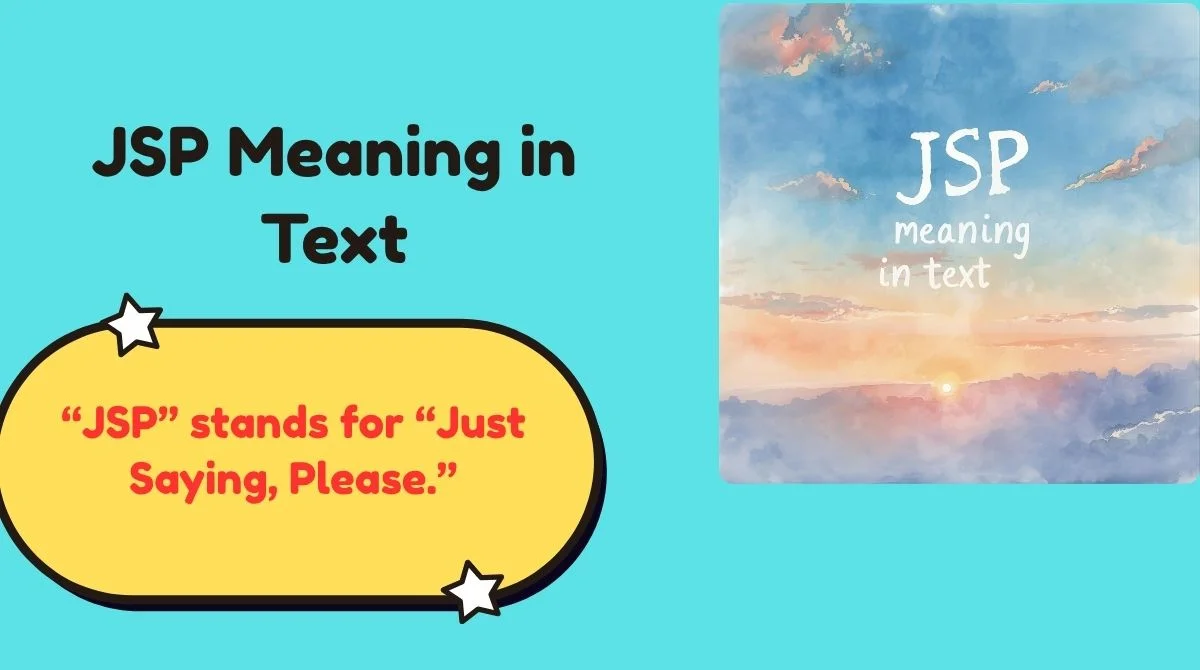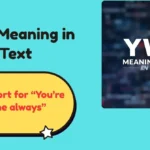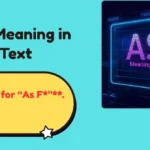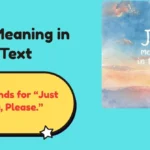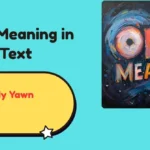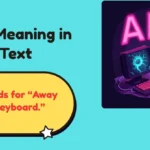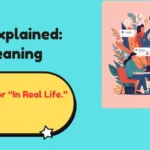Language is constantly evolving, especially in the fast-paced world of texting and social media. Abbreviations like “JSP” and phrases such as “STSU JSP” pop up in chats every day, yet many people don’t fully understand what they imply.
Sometimes they sound casual and lighthearted. Other times, they carry a sharp, passive-aggressive edge.
This guide unpacks the STSU JSP meaning in text, explores how tone shapes interpretation, and offers better, more respectful ways to communicate your thoughts online.
Whether you’re texting friends, messaging coworkers, or posting on social media, understanding JSP can help you avoid misunderstandings and build clearer conversations.
What Does “JSP” Mean in Text?
The abbreviation “JSP” stands for “Just Saying, Please.” It’s often used at the end of a sentence to soften a statement or opinion. The goal is to make the comment sound less harsh or confrontational, even if the message itself is blunt.
Example:
- “That shirt doesn’t really match your shoes, JSP.”
- “I think the meeting ran too long, JSP.”
At first glance, it looks harmless. But the tone behind “JSP” changes everything. In casual conversation, it might come across as playful. In a heated discussion, though, it can sound passive-aggressive or sarcastic.
Real-Life Contexts
- Friendly chats: “JSP” may simply mean “I’m not being serious.”
- Group discussions: It’s often a way to add opinions without taking full responsibility.
- Online debates: It’s used to soften blunt or controversial takes.
People use “JSP” to say something real without sounding like they’re attacking. It’s a shield and a cushion—sometimes helpful, sometimes harmful.
💡 Important Nuance: The Hidden Tone Behind “JSP”
“JSP” is a classic example of how tone can shift meaning dramatically. The phrase itself is neutral, but the context—the who, when, and how—makes it polite, sarcastic, or even rude.
Let’s break down what shapes this tone:
- Relationship between sender and receiver: Close friends are more likely to interpret it as a joke. Strangers may read it as disrespect.
- Timing: Dropping “JSP” in the middle of an argument can escalate tension.
- Punctuation and emojis: “JSP 😅” sounds lighthearted. “JSP.” sounds cold and serious.
Example Scenarios
| Situation | Message | Perceived Tone |
|---|---|---|
| Friendly chat | “You’re late again 😄 JSP” | Teasing, playful |
| Argument | “You’re always late. JSP.” | Sarcastic, passive-aggressive |
| Work group message | “We need better planning next time, JSP” | Critical but softened |
Why it matters: Tone determines how people react to your message. The wrong tone can damage trust or escalate tension—even if your words seem simple.
How Common Is “JSP” Today?
“JSP” isn’t just a Gen Z thing. It’s part of a broader texting culture where shortcuts help people express emotion without typing long sentences.
While abbreviations like LOL or BRB have been mainstream for decades, “JSP” has gained steady ground in the last 5–7 years in casual digital conversations. It’s most common in:
- Messaging apps like WhatsApp, Messenger, and Telegram
- Social platforms like X (formerly Twitter) and Instagram
- Group chats, gaming lobbies, and comment threads
Popularity Trends by Group
- Teens & Young Adults (16–29): Heavy usage in casual and group conversations.
- Professionals (30–45): Occasional use in informal team chats or messages.
- Older Adults (45+): Less common but not unheard of.
Culturally, “JSP” tends to show up more in English-speaking online spaces. But its tone and interpretation can still differ based on personal communication styles.
Why People Use “JSP” (Tone, Intent & Subtext)
People don’t say “JSP” just to be trendy. They use it for specific communication strategies, often subconsciously.
Here are the most common reasons why:
- Softening blunt honesty: It makes strong opinions sound lighter.
- Example: “Your design needs more work, JSP.”
- Creating distance: It lets you share your thoughts while signaling “don’t take this too personally.”
- Testing reactions: It’s a way to say something without committing fully.
- Signaling humor or irony: It can indicate a joke if paired with the right emoji.
- Avoiding confrontation: It helps keep conversations smooth, even when you disagree.
In short, JSP acts like a linguistic cushion. It absorbs some of the emotional force of the words before they hit the receiver.
⚠️ When You Shouldn’t Use “JSP”
Even though “JSP” can be useful, it doesn’t fit every situation. Some conversations require clear, respectful communication, not a soft landing pad.
Here are moments when you should avoid it:
- Formal or sensitive discussions
- Example: Job interviews, professional emails, client communication.
- When delivering constructive criticism
- “Your report needs more detail, JSP” may sound like a backhanded comment.
- When tension is already high
- In arguments, “JSP” can seem dismissive or sarcastic.
- When your relationship with the person isn’t strong
- Without shared context, your tone may be misunderstood.
Misusing “JSP” can make you appear insincere or passive-aggressive—even if that wasn’t your intention.
15 Polite, Professional, or Casual Alternatives to “JSP”
If your goal is to express yourself clearly without sounding harsh, there are plenty of better phrases than “JSP.” The best alternative depends on the tone you want to strike.
Friendly or Casual Alternatives
- “Just a thought”
- “Hope you don’t mind me saying…”
- “Just chiming in.”
- “It’s probably just me, but…”
- “You totally don’t have to agree, but…”
These phrases keep conversations easygoing and open-ended.
Neutral or Considerate Alternatives
- “Take this with a grain of salt…”
- “Just bringing it up for consideration.”
- “Merely offering a suggestion.”
- “No judgment at all.”
- “Let me float an idea.”
These work best when you want to share feedback or ideas without sounding pushy.
Professional or Polite Alternatives
- “From a different perspective…”
- “Only saying this because I care.”
- “Not trying to be rude, just being honest.”
- “Just for your consideration.”
- “No offense intended.”
These fit professional settings where clarity and respect are crucial.
How to Choose the Right Alternative
Choosing the right alternative isn’t about sounding fancy. It’s about matching your tone to the situation.
Ask yourself:
- Who are you talking to?
- What’s the emotional weight of your message?
- How formal or casual is this conversation?
- How do you want your words to be received?
Quick Decision Guide
| Situation | Best Alternative | Why It Works |
|---|---|---|
| Casual chat with a friend | “Just a thought” | Light, non-threatening |
| Work message | “From a different perspective” | Professional and respectful |
| Offering advice | “Hope you don’t mind me saying…” | Gentle, considerate |
| Sharing personal opinion | “It’s probably just me, but…” | Adds personal tone, less confrontational |
| Sensitive feedback | “Just for your consideration.” | Neutral, respectful, non-demanding |
When in doubt, pick clarity over cleverness. It’s better to be kind and clear than sarcastic and misunderstood.
🧠 Expert Tip: How to Avoid Sounding Passive-Aggressive
One of the biggest risks with “JSP” is unintentional passive-aggression. Even if your message is harmless, tone can twist it.
Here’s how to avoid that trap:
- Be intentional with punctuation.
- “JSP 😅” feels warm. “JSP.” can sound cold.
- Skip unnecessary cushions if your message is already polite.
- Add context when needed. A short explanation often prevents misunderstandings.
- Avoid sarcasm unless the person knows your humor well.
- Be direct but kind. Clear communication doesn’t have to be rude.
“The difference between a helpful comment and a hurtful one often comes down to how it’s delivered.”
Modern Usage Trends: Are Abbreviations Like “JSP” Becoming Outdated?
Texting language evolves fast. Words that feel cool today can fade out in a few years. Just look at how “TTYL” or “BRB” gradually gave way to real-time chatting and voice notes.
JSP still has relevance in 2025, but its usage is changing:
- Many people now prefer full phrases like “Just saying” without abbreviating.
- Voice notes and casual texts are making abbreviations less necessary.
- Professional communication leans toward clarity over shortcuts.
- Younger generations use emojis or tone indicators like “/j” (joking) more than “JSP.”
Bottom line: “JSP” isn’t extinct, but its dominance is slowly fading as people value clear tone and intent over quick abbreviations.
📊 Quick Reference Table: “JSP” vs Its Alternatives
| Tone Type | Alternative Phrase | Best Used In | Risk of Misinterpretation |
|---|---|---|---|
| Friendly | “Just a thought” | Group chats, casual banter | Low |
| Professional | “From a different perspective” | Work emails, polite disagreements | Very low |
| Neutral | “Take this with a grain of salt” | Discussions with acquaintances | Moderate |
| Sarcastic | “No offense intended” | Informal, close friends | High |
| Considerate | “Hope you don’t mind me saying…” | Mixed tone, friends or colleagues | Low |
This table makes it easier to pick the right phrase for the right situation.
FAQs About STSU JSP Meaning in Text
What does STSU JSP mean in a text message?
It usually means “Just Saying, Please” and is used to soften statements or opinions in casual digital conversations.
Is JSP considered rude?
Not always. It depends on the tone, context, and relationship between people. In some settings, it can sound passive-aggressive.
Should I use JSP in professional communication?
No. It’s better to use clear, respectful alternatives like “Just for your consideration” in professional settings.
Is JSP still popular in 2025?
Yes, but it’s gradually being replaced by full phrases or tone indicators. It’s more common in casual chats than formal messages.
How can I avoid misunderstandings when using JSP?
Match your tone to the situation, use clear punctuation, and consider replacing JSP with a more transparent phrase.
Final Thoughts
The STSU JSP meaning in text goes beyond three little letters. It’s about how people shape tone, protect feelings, or deflect responsibility in conversations. Used well, it can keep chats smooth and friendly. Used poorly, it can sound sarcastic or passive-aggressive.
Better communication doesn’t need clever shortcuts. It needs clarity, intent, and emotional intelligence. Next time you’re about to type “JSP,” consider your tone, your audience, and the message you truly want to send.
